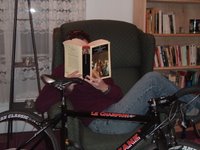I've begun reading Dracula and am discovering how closely it adheres to the gothic style, particularly that of Ann Radcliffe, two books of whose I've read, The Mysteries of Udolpho and The Italian. You have the journey south and east across Europe, complete with stereotypes of superstitious Catholics, exotically-dressed locals, threatening wild beasts, and dangerous climbs over rocky crags. You have the lengthy descriptions of nature, which is both beautiful and threatening -- although I should say it's sublime, to use the appropriate aesthetic term. You have the ever-increasing chaos and uncertainty the further from England the traveler ventures. It's all quite familiar to this avid-eighteenth-century novel reader, except for the trains, but they fit into the pattern as well: "It seems to me the further East you go the more unpunctual are the trains. What ought they to be in China?" We have a punctual, time-table-driven, proper Englishman -- this part strikes me as the Victorian contribution to the eighteenth-century tradition -- traveling to the "exotic" east. I am myself fond of Otranto without being either moved or surprised by it. It seems precisely the sort of novel a neurasthenic antiquarian with bad dreams and plenty of time on his hands would write in two months time "without knowing in the least what [he] intended to say or to relate." The Vampyre is a work almost without merit, having neither memorable characters, a plot worth pursuing, nor any noticeable style,
The introduction to the novel amused me; the editor gives a brief history of gothic novels and vampire stories, and he's got some rather strong opinions on things that he's not afraid to share (I've got The Essential Dracula, subtitled The Definitive Annotated Edition of Bram Stoker's Classic Novel). On The Castle of Otranto, he says:
He admires Radcliffe somewhat more:With Ann Radcliffe's The Mysteries of Udolpho (1794), we have the first fully realized Gothic romance in the history of the genre. Despite its sometimes endless descriptions of places to which its author had never been; despite lapses into fifth-rate poetry; despite even its author's insistence on demystifying her first-rate mysteries, the work has a compelling fascination that commands respect.
High praise, yes? His description of Matthew Lewis's The Monk strikes me as about right:Lewis, at nineteen, as Walpole did at forty-seven, wrote his book at top speed, finishing it in the space of ten weeks. The Monk is a work of wonderful adolescent gusto. The young Lewis intensely enjoyed the lustful and violent extravagances of his villain, Ambrosio, and devoted himself to giving them to us in every macabre and delicious detail.
He does not at all like John Polidori's The Vampyre:
but he likes another vampire tale, Thomas Presket Prest's Varney the Vampyre a bit better:
Varney the Vampyre (1847), a work that has no literary pretensions, is for that reason much more fun to read. The book is an enthusiastic potboiler whose energy almost never flags.
I wouldn't take this editor's judgments too seriously, but he does capture the feeling of a lot of these books, which, with the possible exception of Radcliffe, are more about having a lot of fun than taking care with craft. And there's something wonderful about writing a novel solely in order to have some fun, I'd say.



|